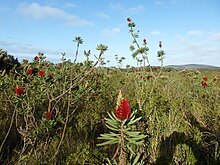Gull Rock National Park is a small national park situated 25 km (16 mi) east of Albany in Western Australia. It was established in 2006, becoming Western Australia's 97th national park in the process.[2] It is around 2,593 hectares (6,407 acres) in area.
| Gull Rock National Park Western Australia | |
|---|---|
 King George Sound from Gull Rock National Park | |
 | |
| Nearest town or city | Albany |
| Coordinates | 35°00′27″S 118°00′12″E / 35.00750°S 118.00333°E |
| Established | 2006 |
| Area | 21.04 km2 (8.1 sq mi)[1] |
| Managing authorities | Department of Environment and Conservation |
| See also | List of protected areas of Western Australia |



Location
editThe area is backed by King George Sound to the south, Oyster Harbour to the west, Taylor Inlet to the east and farmland to the north.[3] The park takes its name from a small island off Ledge Beach, which is not part of the park. Boiler Bay is at the eastern edge of Ledge Beach.[4]
The Mount Martin Botanical Reserve is adjacent to the western boundary and Two Peoples Bay Nature Reserve is approximately 10 kilometres (6 mi) to the east of the park.[5]
Description
editThe area is an almost unspoilt example of coastal east Kalgan vegetation system. Composed of granite headlands separated by sandy beaches with lakes and interdunal wetlands, the area contains a number of specific ecosystems. Rocky granite areas exist, including Mount Taylor and Mount Martin, both of which are part of the Gardner Landform unit.[6]
The diverse landforms and soils support an array of different habitats and a large number of floral species. A complex patchwork of forest, woodlands, wetlands, sedges, granite shrublands and coastal heath is found within the park.[5]
Flora and fauna
editEndangered species such as the noisy scrub-bird, western bristlebird and the western whipbird are known to inhabit the area.[6] The endangered Western ringtail possum is also frequently sighted in the area.[3]
Many rare plant species including Corybas limpidus, Adenanthos cunninghamii, Banksia verticillata and Stylidium plantagineum are also found in the National Park.[7]
Areas of banksia woodland, sheoak forest, open heath and grassed dunes can all be found within the park. Notable flora include Banksia coccinea, Hakea elliptica, Allocasuarina trichodon, Agonis marginata and Dryandra formosa. The area is home to the most significant remaining stands of scarlet banksia, Banksia coccinea, in the region,[4] however this community is threatened by Phytophthora dieback.[5]
Melaleuca striata coastal heath grows on the lower elevations of Mount Taylor. Melaleuca striata, Banksia attenuata and Banksia coccinea are present on the heath, but their growth is stunted by the salt laden air. Anarthria scabra is predominant in the sedgeland, with Adenanthos cuneatus, Astroloma baxteri, Hypocalymma strictum, Hypolaena exsulca, Isopogon cuneatus, Lyginia barbata, Melaleuca thymoides, and Petrophile rigida also present.[8]
The rare and ancient Main's assassin spider, currently listed as threatened, was found to inhabit the park during a survey conducted in 2008.[9]
References
edit- ^ "Department of Environment and Conservation 2009–2010 Annual Report". Annual Report. Department of Environment and Conservation: 48. 2010. ISSN 1835-114X. Archived from the original on 11 January 2011.
- ^ "Annual Report 2005-2006" (PDF). Department of Conservation and Land Management. 2006. Retrieved 6 August 2016.
- ^ a b Minister's office (5 July 2006). "Albany gets WA's newest national park". Department of Environment and Conservation website. Department of Environment and Conservation, Government of Western Australia. Archived from the original on 12 September 2007. Retrieved 28 September 2010.
- ^ a b "Gull Rock National Park". Department of Parks and Wildlife. 2013. Retrieved 6 October 2015.
- ^ a b c "Two Peoples Bay Nature Reserve" (PDF). Department of Environment and Conservation. Archived from the original (PDF) on 21 October 2016. Retrieved 31 July 2016.
- ^ a b "Gull Rock National Park (Place ID 18036)". Australian Heritage Database. Australian Government. 1991. Retrieved 16 September 2010.
- ^ Alan Danks; Andrew A. Burbidge; Allan H. Burbidge; Graeme T. Smith. "Noisy Scrub-bird (Atrichornis clamosus) Recovery Plan". Department of the Environment and Energy. Retrieved 6 August 2016.
- ^ E.M.Sandiford & S.Barrett (2010). "Albany Regional Vegetation Survey" (PDF). Department of Environment and Conservation. Archived from the original (PDF) on 21 October 2016. Retrieved 31 July 2016.
- ^ "Verve Energy Media release - Exciting fin of rare assassins spider found on WA South Coast" (PDF). 2008. Archived from the original (PDF) on 20 February 2011. Retrieved 12 November 2010.
